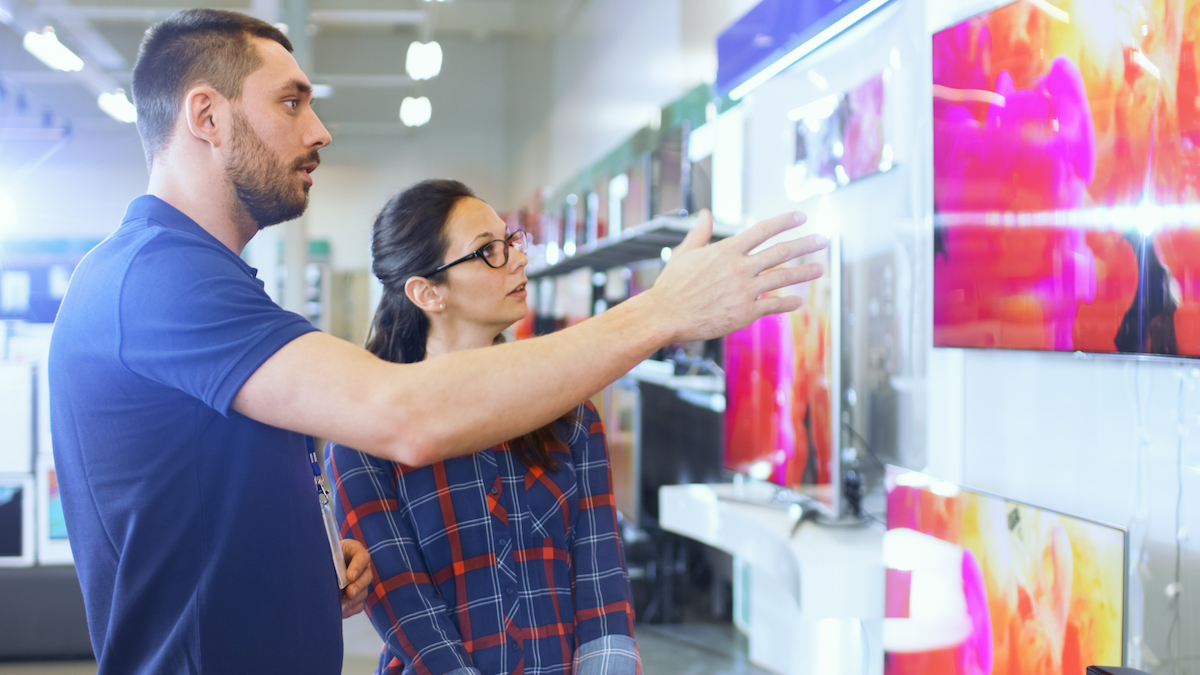
How Digital Engagement Is Reshaping In-Store Buyer Journeys
February 27, 2024 by guest author, Kevin Kroeger
Guest Post: Kevin Kroeger, Spectrio
 In-store digital displays have long been seen as an effective tool for driving store traffic and impulse purchases, but they can also be used to re-shape consumer habits and drive revisits and store loyalty.
In-store digital displays have long been seen as an effective tool for driving store traffic and impulse purchases, but they can also be used to re-shape consumer habits and drive revisits and store loyalty.
Transactional messaging is valuable, of course, in moving the sales needle. But the right screen placements and messaging, combined with technology that drives insights, can improve experiences and turn periodic shoppers into loyal, repeat customers.
The consulting firm PwC did research that found about 73 percent of US consumers regard customer experience as a primary factor in making purchasing decisions, but less than half of US consumers say retailers are providing those good experiences.
Research done by Bain and Company suggested that increasing customer retention by 5% could increase store profits by anywhere from 25% to 95%.
Let’s look at some of the ways the buying journey can be reshaped …
More Time And Understanding
More dwell time in stores tends to lead to increased sales and brand affinity. If shoppers can be converted from quick in-and-out buying missions, to browsing and exploring, purchases are almost certainly going to go up.
Evolved and emerging audience measurement technologies are making it more and more possible and affordable to develop messaging plans that are genuinely tailored to shifting shopper profiles.
Using real-time measurement technologies, like fully anonymous infrared sensors, it’s possible to detect, count and deliver real-time insights on how consumers move around stores, as well as when that happens.
Screens can be positioned where dwell times are high, for example. The dynamics in play can be everything from shoppers considering purchase decisions to deciding where to go next within a store, especially in larger and big-box environments.
Audience measurement technologies can also give retailers and brands a better sense of how shopper dynamics change through a day and week, as the demographics can differ dramatically.
When retailers can understand how shoppers use a store, they can use targeted messaging to create experiences better-tailored to needs and interests.
More Personalized, Reactive Experiences
A vast array of low-cost and entirely inconspicuous sensor technologies make it easier than ever for retailers and their brand partners to deliver very powerful, but simple and reliable, interactive experiences in store.
Tiny sensors and controllers, using well-established technologies like RFID, can convert conventional store merchandising fixtures from static and predictable to reactive.
The everyday shopper habit of picking up goods like shoes, handbags and beauty products is super-charged when simple actions automatically trigger targeted content on screens directly associated with merchandised positions, like a counter or end-cap.
Consider a product line, like personal electronics, that has four physical variations shown on a counter: when of those products is lifted up by a shopper, information specific to it is shown on a screen. The same action can also trigger things like audio messaging and lighting.
On the back-end, those consumer actions can also be logged and analyzing, delivering insights on which products are getting the least and most attention from shoppers. When retailers know what interests shoppers, and what doesn’t, they can adjust and optimize.
These kinds of systems can detect attributes like race and readings on age range and temperment, but they don’t – typically – collect any personally identifiable information. They can detect, but they don’t recognize.
More Connections With Shoppers
If shoppers feel more connected to a retail brand – based on trust, satisfaction and values – they’re going to be more loyal to brands, and often more predisposed to recommending that retailer or brand’s products and services to others.
At least some of that has to do with providing help and guidance. My company works, among many brands, with the German outdoor tools manufacturer STIHL.
Buying power tools like chainsaws and leaf blowers is not an everyday occurrence, so in their stores we developed standalone kiosks that shoppers could use to get educated on the tools and learn more about options. They’re assisted selling tools for store associates, and help start the education process if store staff are busy with other customers – reducing the risk of shoppers leaving.
With another client, US-based big box retailer Dick’s Sporting Goods, we helped make the emotional connection with customers through large video walls and fixtures that emulate sports environments, like faux center-hung replay boards. Smart programming allows stores to optimize the relevance of the messaging to their market, like running broadcasts of the pro and collegiate teams that have a direct affinity to that geographic location.
We also work with the much-loved brand LEGO on experiences across their stores that let shoppers – parents and kids – build their customer journeys like LEGO bricks.
Getting Beyond Transactional
A big part of developing an affinity with shoppers and building lifetime loyalty is moving the relationship beyond transactional. If the messages on screens are all about “On Sale Now!” or “Now Available!”, product may be getting “moved” but there’s nothing that’s genuinely speaking to the needs, interests and goals of shoppers.
Tools and messaging that help shoppers make informed decisions about a retail brand’s products and services are empowering, and can create points of differentiation from the competition.
Imagine a lift and learn campaign for Air Jordans at DSG. Shopper goes into a store, picks up a merchandised pair of the kicks, and Nike brand-specific content starts to play on a screen at the fixture or table that shows Michael Jordan talking about the inspiration for this new model, with cool in-depth content. It’s the sort of thing that builds brand affinity.
In-store screens can do a great job of earning business the first time around, but they can also do the work to take care of them – and make them want to come back. And that can have big bottom line impacts.
About The Writer
Kevin Kroeger is the Product Manager for Spectrio’s Retail Vertical. He oversees product development lifecycle, market dynamics and the competitive landscape to drive planning, positioning, roadmap, requirements, and launch activities. He is based in Phoenix.



Leave a comment